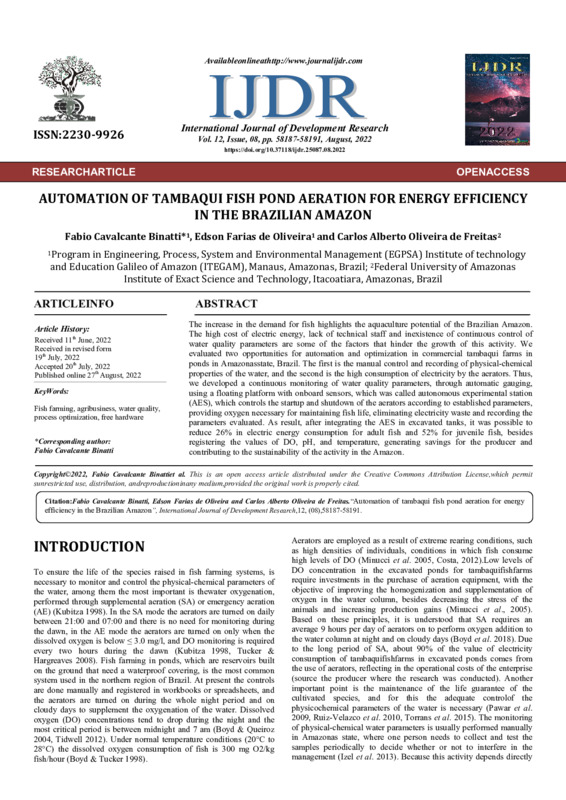-
Tipo do ITEM
-
Artigo Ciêntifico
-
Título do Artigo
-
AUTOMATION OF TAMBAQUI FISH POND AERATION FOR ENERGY EFFICIENCY IN THE BRAZILIAN AMAZON
-
Descrição
-
The increase in the demand for fish highlights the aquaculture potential of the Brazilian Amazon.The high cost of electric energy, lack of technical staff and inexistence of continuous control ofwater quality parameters are some of the factorsthat hinder the growth of this activity. We evaluated two opportunities for automation and optimization in commercial tambaqui farms in ponds in Amazonasstate, Brazil. The first is the manual control and recording of physical-chemical properties of the water, and the second is the high consumption of electricity by the aerators. Thus, we developed a continuous monitoring of water quality parameters, through automatic gauging, using a floating platform with onboard sensors, which was called autonomous experimental station (AES), which controls the startup and shutdown of the aerators according to established parameters, providing oxygen necessary for maintaining fish life, eliminating electricity waste and recording the parameters evaluated. As result, after integrating the AES in excavated tanks, it was possible to reduce 26% in electric energy consumption for adult fish and 52% for juvenile fish, besides
registering the values of DO, pH, and temperature, generating savings for the producer and contributing to the sustainability of the activity in the Amazon.
-
Abstract
-
The increase in the demand for fish highlights the aquaculture potential of the Brazilian Amazon.The high cost of electric energy, lack of technical staff and inexistence of continuous control ofwater quality parameters are some of the factorsthat hinder the growth of this activity. We evaluated two opportunities for automation and optimization in commercial tambaqui farms in ponds in Amazonasstate, Brazil. The first is the manual control and recording of physical-chemical properties of the water, and the second is the high consumption of electricity by the aerators. Thus, we developed a continuous monitoring of water quality parameters, through automatic gauging, using a floating platform with onboard sensors, which was called autonomous experimental station (AES), which controls the startup and shutdown of the aerators according to established parameters, providing oxygen necessary for maintaining fish life, eliminating electricity waste and recording the parameters evaluated. As result, after integrating the AES in excavated tanks, it was possible to reduce 26% in electric energy consumption for adult fish and 52% for juvenile fish, besides
registering the values of DO, pH, and temperature, generating savings for the producer and contributing to the sustainability of the activity in the Amazon.
-
Língua do arquivo
-
inglês
-
Data da Publicação
-
Ano 2022
-
Palavra-chave
-
Fish farming
-
agribusiness
-
water quality
-
process optimization
-
free hardware
-
Autores
-
Fabio Cavalcante Binatti
-
Edson Farias de Oliveira
-
Carlos Alberto Oliveira de Freitas
-
Local
-
ITEGAM - Manaus, 2022
-
Áreas de Conhecimento
-
Eficiência Energética e Qualidade de Energia
-
Turma
-
EFICIÊNCIA ENERGÉTICA E QUALIDADE DE ENERGIA


